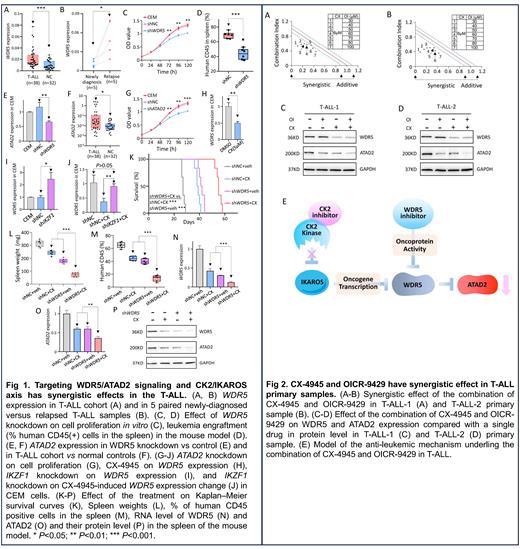Background WD repeat-containing protein 5 (WDR5) is highly expressed in human cancers and its high expression is linked with adverse prognoses. However, the oncogenic roles of WDR5 and underlying mechanisms are undefined in T-cell acute lymphoblastic leukemia (T-ALL). Casein Kinase II (CK2) is a pro-oncogene, and CK2-mediated IKAROS dysfunction plays critical roles in high-risk ALL, and CK2 inhibitor CX-4945 has the anti-leukemic effect by restoring IKAROS function. This study aims to explore the synergistic anti-leukemic efficacy of dual targeting novel WDR5/ATAD2 oncogenic signaling via the CK2/IKAROS axis in T-ALL.
Methods Clinical samples from 38 T-ALL patients and 32 healthy controls were obtained from Zhongda Hospital Southeast University. The expression of WDR5 and ATAD2 were tested by q-PCR and Western blot. RNA-seq was performed after CEM cells were treated with WDR5 inhibitor (OICR-9429), CX-4945 and vehicle control for 72 hours. The human leukemia xenograft mouse model is established by intravenously injected with WDR5 knockdown CEM (CEM-shWDR5) cells and shRNA control (CEM-shNC) into NSG mice. Mice were treated for 25 days in 4 groups [CEM-shNC + vehicle, CEM-sh WDR5 + vehicle; CEM-shNC + CX-4945 (100 mg/kg via gavage), CEM-sh WDR5 + CX-4945]. Leukemia burden in mice spleen and bone marrow was analyzed by flow cytometry. The survival of mice was compared by the Kaplan-Meier method. The synergistic effect of CX-4945 and OICR-9429 was analyzed by CCK8 assay. This study was approved by the Ethics Committee of Zhongda Hospital Southeast University
ResultsWDR5 ishighly expressed in T-ALL patients compared with normal controls( P<0.001) and is higher in the relapsed samples than paired newly-diagnosed controls ( P<0.05) (Fig. 1A-B). WDR5 knockdown in T-ALL cells significantly suppressed cell proliferation and induced cell cycle arrest in vitro ( P<0.01) (Fig. 1C), and in vivo leukemia development (Fig. 1D). Also, WDR5 inhibitor OICR-9429 induces cell proliferation and cell cycle arrest in the cells. RNA-seq revealed that ATAD2 is downregulated upon OICR-9429 treatment and indicated that ATAD2 is the downstream target of WDR5. WDR5 knockdown suppresses ATAD2 expression ( P<0.01) (Fig. 1E). In addition, ATAD2 ishighly expressed in T-ALL patients versus normal controls ( P<0.05) (Fig. 1F), and ATAD2 silencing significantly suppresses cell proliferation and induces cell cycle arrest of T-ALL cells ( P<0.01) (Fig. 1G). These data indicate WDR5/ATAD2 signaling act as a novel potential oncogenic pathway in T-ALL.
Furthermore, we found that IKAROS transcriptionally suppresses WDR5 expression, and CK2-mediated hyperphosphorylation of IKAROS is one of the major mechanisms of IKAROS dysfunction in ALL. CX-4945 strongly suppresses WDR5 expression in an IKAROS-dependent manner (Fig. 1H-J). The synergistic effect of CX-4945 with WDR5 disruption on cell proliferation suppression and cell cycle arrest was observed in T-ALL both in in vitro and in vivo xenograft mouse model. The combination of CX-4945 with WDR5 disruption significantly prolonged the survival of mice compared with single CX-4945 [55(52-58) days vs. 38.5(36-41) days, P<0.001] and single WDR5 disruption control [55(52-58) days vs. 41.5(39-44) days, P<0.001] (Fig. 1K). Consistently, the combination significantly reduces the size and weight of the spleen (Fig. 1L), % human CD45+ T-ALL cells in the spleen (Fig. 1M) and bone marrow (data not shown), and the expression of WDR5 and ATAD2 in the spleen versus single treatment controls ( P<0.01) (Fig. 1N-P). Finally, a synergistic effect of CX-4945 with OICR-9429 on cell proliferation suppression and down-regulation of WDR5 and ATAD2 was observed in the primary leukemic cells from T-ALL patients (Fig. 2A-D). Together, these data indicated the synergistic efficacy of CX-4945 with OICR-9429 on T-ALL and the novel model was summarized in Fig.2E.
Conclusion In this study, we identified a novel WDR5/ATAD2 oncogenic signaling regulated by CK2/IKAROS axis in T-ALL. Our study reveals a model that dual targeting WDR5/ATAD2 signaling through direct inhibiting oncoproteins and via CK2/IKAROS axis to transcriptionally repress the oncoprotein to achieve synergistic efficacy. Our results further highlight the combination of CX-4945 with WDR5 inhibition is a potential option for the therapy of T-ALL patients.
Disclosures
No relevant conflicts of interest to declare.


This feature is available to Subscribers Only
Sign In or Create an Account Close Modal